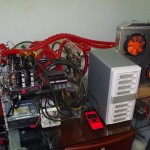One of the major improvements with the CacheCade Pro version is that write data can also be cached. The write caching is a tremendous accelerator for any HDD array, be it large or small. One of the major weaknesses of any storage medium is writing, especially in mixed read/write scenarios. An unfortunate side-effect of writing is that it slows down …
Read More »Raid/Enterprise
LSI MegaRAID CacheCade Pro 2.0 Review – Exploring TCO
TCO is an acronym which stands for ‘Total Cost of Ownership’. This is one of the most important measurements that must be taken into consideration when deciding whether or not to upgrade. Basically put…What is this going to cost and is it a viable investment? When confronted with the thought of upgrading to SSDs, many will balk at the prohibitive …
Read More »LSI MegaRAID CacheCade Pro 2.0 Review – Test Bench and Protocol
This is the Test Bench. As you may have guessed, it truly is no ordinary Test Bench, and I have dedicated many many hours creating this build which has been used in many benchmarking excursions and extreme overclocking sessions. She has even set a few HWBot world records along the way! Our main focal point in this report will be …
Read More »LSI MegaRAID CacheCade Pro 2.0 Review – Single Zone Results
One of the hardest situations to simulate with IOmeter is the acceleration of arrays with rapidly changing data in a caching scenario. Writing test files to a Base Array with a CacheCade Pro Volume enabled resulted in a very quick pace of acceleration. Once the test file is written in its entirety, the ramp is almost instantaneous. What we are …
Read More »LSI MegaRAID CacheCade Pro 2.0 Review – Overlapped Region Results
With each page we are progressing into more difficult scenarios. The ‘overlapped regions’ is one of the most complex access patterns. It is much more demanding of the caching algorithm. What we are simulating is a scenario that would be found typically in a large dataset on a typical server. The areas of the disk that are hot data are …
Read More »LSI MegaRAID CacheCade Pro 2.0 Review – Real World Results and Conclusion
All of our extensive testing with Iometer is, at the end of the day, merely synthetic testing. A program such as this is no easy task to benchmark, especially when using synthetic measurements. The main thrust of the testing is to reproduce situations that are similar to real world applications and how they would behave. I feel that, if anything, …
Read More »Areca ARC-4036 6Gb/s SAS/SATA JBOD Enclosure Review – Areca, LSI, Sandisk and Patriot Perform!
The storage industry is shifting from 3Gb/s devices to the new 6Gb/s specification which has been a boon to manufacturers as new devices are needed to handle the new, faster devices that 6Gb/s enables. The 3Gb/s specification reigned for roughly five years which allowed user speeds up to 300 MB/s. With the advent of “disruptive” technologies like SSD devices, the …
Read More »Areca ARC-4036 6Gb/s SAS/SATA JBOD Enclosure Review – JBODs And Expanders – Concepts and Usage
First, to understand the use of the expander you have to understand the concepts of how the device is connected to the system. Usually one would use a RAID controller, or HBA (Host Bus Adapter) to connect to a large array of either SSD or HDD. This is usually accomplished by a few standard methods. In server environments controllers are …
Read More »Areca ARC-4036 6Gb/s SAS/SATA JBOD Enclosure Review – Unboxing
We received the unit in a plain box, and on opening it, we found this very sturdy box packed inside which, of course, contained the unit.On opening the box, we were greeted with bubble wrap and air packs to cover the top items as you see here; the power cord, manual, screws and connectors.The unit itself was packed perfectly, well …
Read More »Areca ARC-4036 6Gb/s SAS/SATA JBOD Enclosure Review – Internals
We have received the unit and inspected the outer characteristics and now feel it’s time to take off the cover and see what’s under the hood. This side of the enclosure is pretty straightforward and we are only including the view to show the slots on the drawers that the trays slide into. On the right the long horizontal slots …
Read More » The SSD Review The Worlds Dedicated SSD Education and Review Resource |
The SSD Review The Worlds Dedicated SSD Education and Review Resource | 

